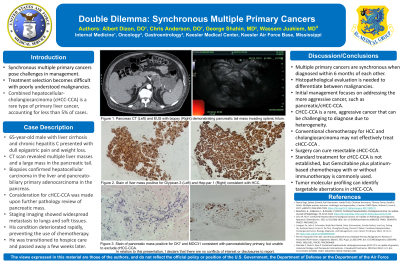Monday Poster Session
Category: Liver
P2987 - Double Dilemma: Synchronous Multiple Primary Cancers
Monday, October 28, 2024
10:30 AM - 4:00 PM ET
Location: Exhibit Hall E

Has Audio

Albert Dizon, DO
United States Air Force
Biloxi, MS
Presenting Author(s)
Albert Dizon, DO, Christopher Anderson, DO, George Shahin, MD, Wassem Juakiem, MS, MD
United States Air Force, Biloxi, MS
Introduction: Synchronous multiple primary cancers are a rare occurrence and can present unique challenges in management compared to single primary cancers. Selecting the appropriate treatment becomes even more difficult when faced with a malignancy that is poorly understood. We present a case of synchronous primary cancers of the liver and pancreas.
Case Description/Methods: A 65-year-old male with a history of liver cirrhosis secondary to chronic hepatitis C was evaluated for one month of epigastric pain and weight loss. Further evaluation with CT of the abdomen found multiple masses within the liver and a 5.6 x 8.0 cm mass within the pancreatic tail. Endoscopic ultrasound with biopsies of the liver mass and pancreatic mass were consistent with hepatocellular carcinoma (HCC) and pancreato-biliary primary adenocarcinoma respectively. The combined hepatocellular-cholangiocarcinoma (cHCC-CCA) variant was unable to be ruled out upon further pathology review. Additionally, he was found to have suspected metastasis to the lungs, psoas, and mediastinum.
Tentative plans were made to start a platinum containing regimen. Unfortunately, due to the patient’s disease burden, he quickly deteriorated, and the patient was placed on hospice. The patient passed away after 1 month of presenting with symptoms.
Discussion: This case illustrates the difficult diagnosis of rare yet highly aggressive cancer that should be considered when a patient presents with a liver or biliary malignancy. cHCC-CCA is a primary liver carcinoma that has the presence of both hepatocyte and cholangiocyte differentiation within the same tumor. The heterogenous nature and nonspecific presentation can make diagnosis challenging. Less than 5% of patients with primary liver tumors will have this rare combination and carries a worse prognosis compared to HCC and cholangiocarcinoma. While cHCC-CCA exhibits phenotypical similarities with both HCC and cholangiocarcinoma, conventional chemotherapy regimens for these cancers do not effectively treat cHCC-CCA. Therefore, correctly distinguishing cHCC-CCA from other biliary or liver cancers is integral for appropriate treatment. In the setting of synchronous multiple primary cancers, histopathological evaluation is necessary to differentiate between malignancies. Initial management would be to address the more aggressive of the two cancers, which in this case would be the pancreatic/cHCC-CCA. Cure can be achieved through surgery and systemic therapy have been extrapolated from HCC and cholangiocarcinoma.
Disclosures:
Albert Dizon, DO, Christopher Anderson, DO, George Shahin, MD, Wassem Juakiem, MS, MD. P2987 - Double Dilemma: Synchronous Multiple Primary Cancers, ACG 2024 Annual Scientific Meeting Abstracts. Philadelphia, PA: American College of Gastroenterology.
United States Air Force, Biloxi, MS
Introduction: Synchronous multiple primary cancers are a rare occurrence and can present unique challenges in management compared to single primary cancers. Selecting the appropriate treatment becomes even more difficult when faced with a malignancy that is poorly understood. We present a case of synchronous primary cancers of the liver and pancreas.
Case Description/Methods: A 65-year-old male with a history of liver cirrhosis secondary to chronic hepatitis C was evaluated for one month of epigastric pain and weight loss. Further evaluation with CT of the abdomen found multiple masses within the liver and a 5.6 x 8.0 cm mass within the pancreatic tail. Endoscopic ultrasound with biopsies of the liver mass and pancreatic mass were consistent with hepatocellular carcinoma (HCC) and pancreato-biliary primary adenocarcinoma respectively. The combined hepatocellular-cholangiocarcinoma (cHCC-CCA) variant was unable to be ruled out upon further pathology review. Additionally, he was found to have suspected metastasis to the lungs, psoas, and mediastinum.
Tentative plans were made to start a platinum containing regimen. Unfortunately, due to the patient’s disease burden, he quickly deteriorated, and the patient was placed on hospice. The patient passed away after 1 month of presenting with symptoms.
Discussion: This case illustrates the difficult diagnosis of rare yet highly aggressive cancer that should be considered when a patient presents with a liver or biliary malignancy. cHCC-CCA is a primary liver carcinoma that has the presence of both hepatocyte and cholangiocyte differentiation within the same tumor. The heterogenous nature and nonspecific presentation can make diagnosis challenging. Less than 5% of patients with primary liver tumors will have this rare combination and carries a worse prognosis compared to HCC and cholangiocarcinoma. While cHCC-CCA exhibits phenotypical similarities with both HCC and cholangiocarcinoma, conventional chemotherapy regimens for these cancers do not effectively treat cHCC-CCA. Therefore, correctly distinguishing cHCC-CCA from other biliary or liver cancers is integral for appropriate treatment. In the setting of synchronous multiple primary cancers, histopathological evaluation is necessary to differentiate between malignancies. Initial management would be to address the more aggressive of the two cancers, which in this case would be the pancreatic/cHCC-CCA. Cure can be achieved through surgery and systemic therapy have been extrapolated from HCC and cholangiocarcinoma.
Disclosures:
Albert Dizon indicated no relevant financial relationships.
Christopher Anderson indicated no relevant financial relationships.
George Shahin indicated no relevant financial relationships.
Wassem Juakiem indicated no relevant financial relationships.
Albert Dizon, DO, Christopher Anderson, DO, George Shahin, MD, Wassem Juakiem, MS, MD. P2987 - Double Dilemma: Synchronous Multiple Primary Cancers, ACG 2024 Annual Scientific Meeting Abstracts. Philadelphia, PA: American College of Gastroenterology.
